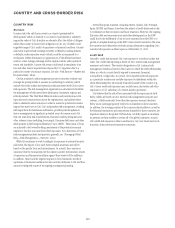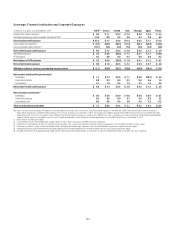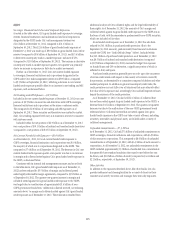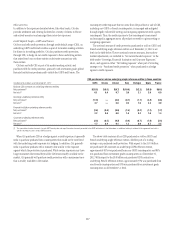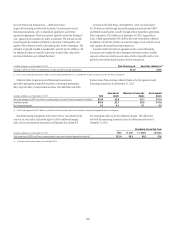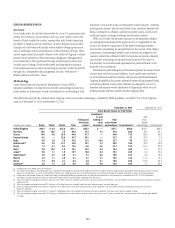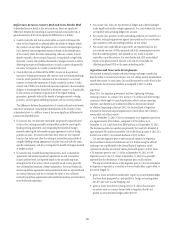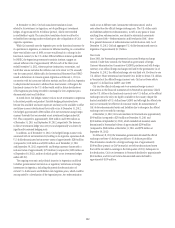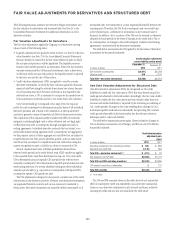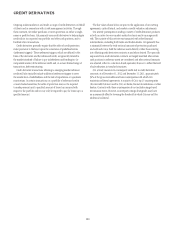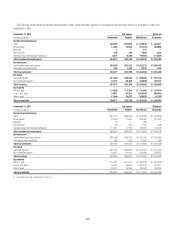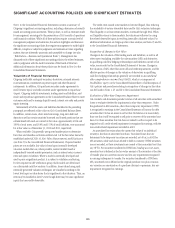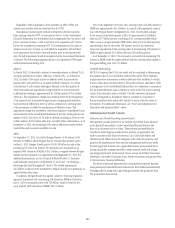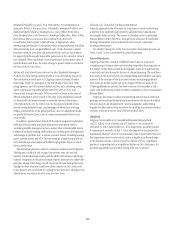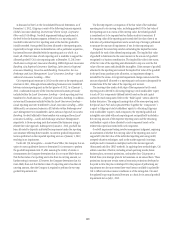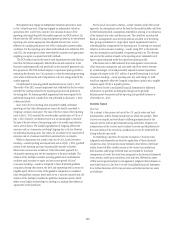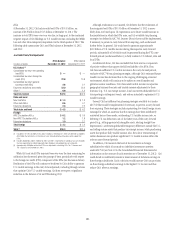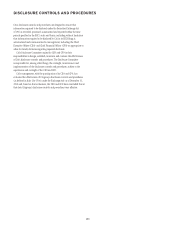Citibank 2012 Annual Report Download - page 145
Download and view the complete annual report
Please find page 145 of the 2012 Citibank annual report below. You can navigate through the pages in the report by either clicking on the pages listed below, or by using the keyword search tool below to find specific information within the annual report.
123
FAIR VALUE ADJUSTMENTS FOR DERIVATIVES AND STRUCTURED DEBT
The following discussion relates to the derivative obligor information and
the fair valuation for derivatives and structured debt. See Note 23 to the
Consolidated Financial Statements for additional information on Citi’s
derivative activities.
Fair Valuation Adjustments for Derivatives
The fair value adjustments applied by Citigroup to its derivative carrying
values consist of the following items:
• Liquidity adjustments are applied to items in Level 2 or Level 3 of the fair-
value hierarchy (see Note 25 to the Consolidated Financial Statements
for more details) to ensure that the fair value reflects the price at which
the net open risk position could be liquidated. The liquidity reserve is
based on the bid/offer spread for an instrument. When Citi has elected to
measure certain portfolios of financial investments, such as derivatives,
on the basis of the net open risk position, the liquidity reserve is adjusted
to take into account the size of the position.
• Credit valuation adjustments (CVA) are applied to over-the-counter
derivative instruments, in which the base valuation generally discounts
expected cash flows using the relevant base interest rate curves. Because
not all counterparties have the same credit risk as that implied by the
relevant base curve, a CVA is necessary to incorporate the market view of
both counterparty credit risk and Citi’s own credit risk in the valuation.
Citi’s CVA methodology is composed of two steps. First, the exposure
profile for each counterparty is determined using the terms of all individual
derivative positions and a Monte Carlo simulation or other quantitative
analysis to generate a series of expected cash flows at future points in time.
The calculation of this exposure profile considers the effect of credit risk
mitigants, including pledged cash or other collateral and any legal right
of offset that exists with a counterparty through arrangements such as
netting agreements. Individual derivative contracts that are subject to an
enforceable master netting agreement with a counterparty are aggregated
for this purpose, since it is those aggregate net cash flows that are subject to
nonperformance risk. This process identifies specific, point-in-time future
cash flows that are subject to nonperformance risk, rather than using the
current recognized net asset or liability as a basis to measure the CVA.
Second, market-based views of default probabilities derived from
observed credit spreads in the credit default swap (CDS) market are applied
to the expected future cash flows determined in step one. Citi’s own-credit
CVA is determined using Citi-specific CDS spreads for the relevant tenor.
Generally, counterparty CVA is determined using CDS spread indices for each
credit rating and tenor. For certain identified netting sets where individual
analysis is practicable (e.g., exposures to counterparties with liquid CDS),
counterparty-specific CDS spreads are used.
The CVA adjustment is designed to incorporate a market view of the credit
risk inherent in the derivative portfolio. However, most derivative instruments
are negotiated bilateral contracts and are not commonly transferred to
third parties. Derivative instruments are normally settled contractually or, if
terminated early, are terminated at a value negotiated bilaterally between the
counterparties. Therefore, the CVA (both counterparty and own-credit) may
not be realized upon a settlement or termination in the normal course of
business. In addition, all or a portion of the CVA may be reversed or otherwise
adjusted in future periods in the event of changes in the credit risk of Citi or
its counterparties, or changes in the credit mitigants (collateral and netting
agreements) associated with the derivative instruments.
The table below summarizes the CVA applied to the fair value of derivative
instruments for the periods indicated:
Credit valuation adjustment
contra-liability (contra-asset)
In millions of dollars
December 31,
2012
December 31,
2011
Non-monoline counterparties $(2,971) $(5,392)
Citigroup (own) 918 2,176
Total CVA—derivative instruments $(2,053) $(3,216)
Own Debt Valuation Adjustments for Structured Debt
Own debt valuation adjustments (DVA) are recognized on Citi’s debt
liabilities for which the fair value option (FVO) has been elected using Citi’s
credit spreads observed in the bond market. Accordingly, the fair value of debt
liabilities for which the fair value option has been elected (other than non-
recourse and similar liabilities) is impacted by the narrowing or widening of
Citi’s credit spreads. Changes in fair value resulting from changes in Citi’s
instrument-specific credit risk are estimated by incorporating Citi’s current
credit spreads observable in the bond market into the relevant valuation
technique used to value each liability.
The table below summarizes pretax gains (losses) related to changes in
CVA on derivative instruments, net of hedges, and DVA on own FVO debt for
the periods indicated:
Credit/debt valuation
adjustment gain
(loss)
In millions of dollars 2012 2011
Derivative counterparty CVA, excluding monolines $ 805 $ (830)
Derivative own-credit CVA (1,126) 863
Total CVA—derivative instruments (1) $ (321) $ 33
DVA related to own FVO debt $(2,009) $1,773
Total CVA and DVA excluding monolines $(2,330) $1,806
CVA related to monoline counterparties 2179
Total CVA and DVA $(2,328) $1,985
(1) Net of hedges
The CVA and DVA amounts shown in the table above do not include the
effect of counterparty credit risk embedded in non-derivative instruments.
Losses on non-derivative instruments, such as bonds and loans, related to
counterparty credit risk are also not included in the table above.


